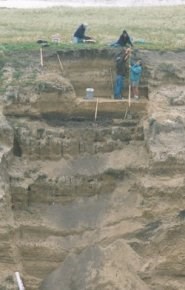

Arlington Springs: The Earliest Evidence for Paleoindians in Coastal California
Arlington Springs Man lived at the end of the Pleistocene when the four northern Channel Islands were all still united together as one mega-island, and the climate was much cooler than today. The evidence that people had arrived on that island by 13,000 years ago demonstrates that watercraft were in use along the California coast at that early date and lends support for a theory that the earliest peoples to enter the Western Hemisphere may have migrated along the Pacific coast from Siberia and Alaska using boats. Recent radiocarbon dating by Dr. Larry Agenbroad of pygmy mammoth fossils from Santa Rosa Island suggests that the last of these unique mammals may have been present on the island at the time the first humans arrived.
An interdisciplinary team of archaeologists and geologists has been investigating the Arlington Springs locality over the past twelve years. In 2001 detailed studies were conducted to date the geological layers at the site and collect information regarding the late Pleistocene environment on Santa Rosa Island. New technologies, such as laser mapping and ground penetrating radar have been used to document the site and gather additional information to guide future research. During the most recent field season, a series of soil cores were obtained that will yield invaluable information about the geological and environmental history of the island. |
Last updated: June 7, 2016
